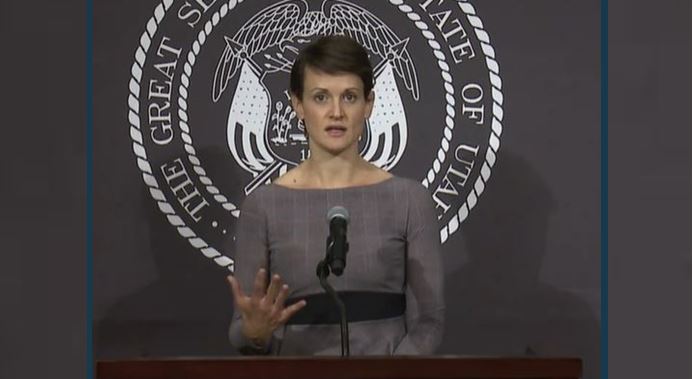UTAH, June 22, 2020 (Gephardt Daily) — State epidemiologist Dr. Angela Dunn is warning another shutdown might be necessary to control the COVID-19 outbreak in Utah.
In a Utah Department of Health memo sent to the state’s COVID-19 Unified Command Friday and released to the public Monday, Dunn writes:
“We are in the acceleration phase of the COVID-19 outbreak in Utah. We went yellow on May 15. Our surge in cases started on May 27, 12 days after going yellow. Utahns care about these colors. They change their actions based on them. They are the key messaging tool to the public.
“All of our goals are aligned — keep the economy open and prevent deaths/ illnesses. We are quickly getting to a point where the only viable option to manage spread and deaths will be a complete shutdown. This might be our last chance for course correction. Contact tracing and testing alone will not control this outbreak.”
The memo said that nearly 600 cases were reported Friday “and that’s without a known outbreak of driving transmission.”
The memo adds these bullet points:
• It’s over 3.5 times the current rate in Colorado.
• COVID-19 patients in the Utah hospitals have increased from a steady 90 to 150 this month, and this increase is from the cases that were identified over a week ago.
• IHC is reporting they will run out of conventional ICU capacity in some hospitals in July.
• Of the cases, about 8 percent will be hospitalized one to two weeks later and about 1% will die after about three weeks. If trends hold, at the current weekly average of 405 cases/day:
o This means around 213 people will be hospitalized per week.
o Of those 213, about 85 will be previously healthy working age people. “Low risk” — taken
from their family and work to fight for their lives in an isolated hospital room.
o About 17 of the 213 will die — another 11 will die at home or in nursing homes. On
average, per week, and it’s growing at a rate of 25% a week.
Dunn also includes a list of items to do now to start to decrease cases and keep the economy open:
1. If we do not reach a rolling 7-day average of 200/cases per day by July 1, we need to move the entire state to orange. This will send the message to Utahns that this outbreak continues to be a serious problem, and state leadership is committed to saving lives and preventing a complete economic shutdown.
a. 200 new cases / day can likely be managed by aggressive contact tracing, focused
outbreak investigations and testing, and pointed public messaging.
b. We should start messaging this to the public and businesses now.
c. Put a pause on any jurisdiction lessening restrictions until July 1.
2. Mandate face coverings, either by government or business enforcement.
3. If above isn’t reasonable, we need to be clear with public about why decisions are being made lessening restrictions — economic, not health. Be clear about health risk. Be clear about how these decisions are made and who makes them. This will better equip the public to make informed decisions about how to protect themselves and their health.
The memo also includes the following key aspects of Utah’s response:
1. Contact Tracing
Contact tracing is a key element to controlling an infectious disease outbreak. However, it
becomes less effective as the number of contacts per case increases, and as the public perceives lower risk and does not adhere to quarantine recommendations. Since going to yellow, we have increased our number of contacts/case from approximately five to over 20. For contact tracing to be effective as a tool to stopping the spread of COVID-19, it needs to be paired with polices that limit the number of close contacts per person. We are exceeding our capacity to effectively and efficiently conduct contact tracing due to the surge in cases and number of contacts per case.
2. Testing
We need to continue our ability to test everyone who needs a COVID-19 test: close contacts, symptomatic, high risk settings. We must prioritize testing for people who are sick or are part of outbreaks. Speed is critical in identifying these people and baseline testing distracts public health and testing resources.
3. Hospital Utilization
We have heard from the UHA, U of U, and IHC that hospitals are going to exceed their capacity to care for individuals within the next 4-8 weeks. The metrics on DOMO are only part of the hospital capacity. We must consider staffing, ECMO, and beds for severe cases. Focusing on tertiary care hospitals is crucial. Once we run out of beds at tertiary care hospitals on the Wasatch Front, there is no state ability to care for the critically ill. Maintaining the ability to stand up the alternate care facility will be essential as cases continue to increase.
4. Protect those at high risk for severe disease
High risk individuals get COVID-19 from low risk individuals. The higher the number of cases in our state, the more likely high risk individuals will get exposed to COVID-19. We must continue our efforts to specifically protect those at high risk for severe disease, while prioritizing policies and interventions that drive down overall transmission.
5. Protect those at high risk for transmission
We know certain environments are more conducive to COVID-19 spread: crowded, indoors, for a prolonged period of time. We must continue to work with employers in these environments to put procedures in place and engineer the workspace to limit spread. We also need to work with employers to ensure their employees have the ability to quarantine and isolate when needed through paid sick leave and worker protections.
6. Messaging/Communications
The public equates the color-coded phased guidelines with risk of COVID-19 spread. We must be clear that the color equates with the economic restrictions in place. And that the risk of COVID- 19 spread is higher as the restrictions are lower.







Southern Utah has so many out of staters vacationing here, our numbers can help but increase.